Enter the balance board, a simple and cheap tool that can take your training to the next—and far more interesting—level by introducing a stability component. Not only will training with a stability board make strength workouts easier, you'll also feel stronger and more stable while running.
We pulled eight runner-friendly exercises—and two stretches—from the book Stability Workouts on the Balance Board, by Dr. Karl Knopf, for you to try at home. All you need is a board and your own body weight (see, we told you it was easy).
Note: If you're new to balance boards, use a chair or wall with these moves for added support.
Rock Around the Clock (Part 1)
Benefits: Works core and improves ankle flexibility. 1 of 25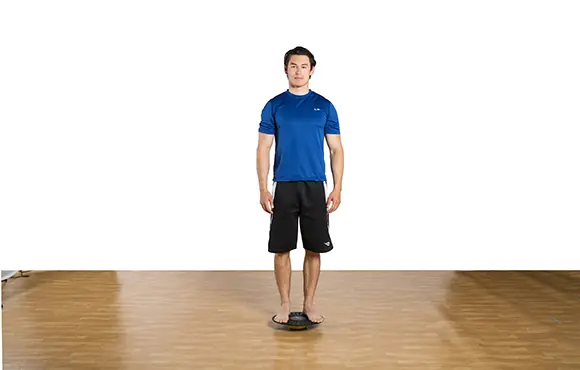
Stand on the balance board with your feet a comfortable distance apart and weight evenly supported.
Read More
Running ArticlesRock Around the Clock (Part 2)
Benefits: Works core and improves ankle flexibility. 2 of 25
By shifting your feet and body weight, move the board in a clockwise direction, then counterclockwise.
Read More
Running ArticlesRock Around the Clock (Part 3)
Benefits: Works core and improves ankle flexibility. 3 of 25
Rock forward and back.
Read More
Running ArticlesRock Around the Clock (Part 4)
Benefits: Works core and improves ankle flexibility. 4 of 25
Move side to side.
Read More
Running ArticlesStanding Empire State Building (Part 1)
Benefits: Increases core, leg and ankle stamina. 5 of 25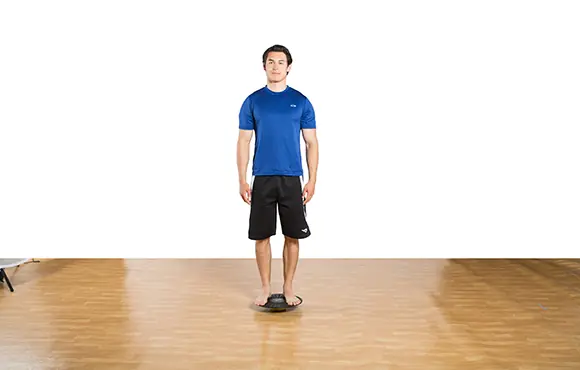
Stand on the balance board with your feet a comfortable distance apart and weight evenly supported.
Read More
Running ArticlesStanding Empire State Building (Part 2)
Benefits: Increases core, leg and ankle stamina. 6 of 25
Looking up, see how long you can maintain your balance.
Read More
Running ArticlesStanding Empire State Building (Part 3)
Benefits: Increases core, leg and ankle stamina. 7 of 25
Repeat while looking down.
Read More
Running ArticlesPlank (Part 1)
Benefits: Builds core muscles. 8 of 25
Place your hands on the balance board and extend your legs behind you, placing your feet on the floor. Your legs can be spread apart to provide better balance, but your body should form one straight line from head to heels.
Read More
Running ArticlesPlank (Part 2)
Benefits: Builds core muscles. 9 of 25
Hold correct form for as long as you can. Keep your tailbone in line with the rest of your body.
Read More
Running ArticlesDynamic Squat (Part 1)
Benefits: Works core and increases leg stamina. 10 of 25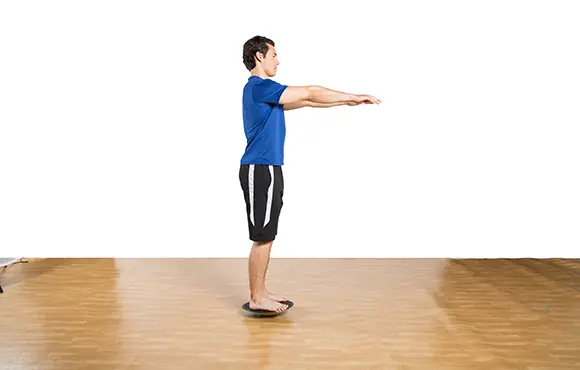
Stand on the balance board with your feet a comfortable distance apart and weight evenly supported. Hold your arms either in front of you or to the side for balance.
Read More
Running ArticlesDynamic Squat (Part 2)
Benefits: Works core and increases leg stamina. 11 of 25
Lower yourself up and down at a comfortable pace without losing your balance or rocking too much.
Read More
Running ArticlesScales (Part 1)
Benefits: Increase core stability and leg stamina. 12 of 25
Place your left foot in the center of the balance board and the other foot on the floor behind you. Find your balance point and place your hands on your hips. Once steady, lean forward from your hips until your back foot lifts off the floor. Keeping your body straight, continue bending at the hip until you form a line from head to heel.
Read More
Running ArticlesScales (Part 2)
Benefits: Increase core stability and leg stamina. 13 of 25
Bring foot down and repeat on other leg.
Read More
Running ArticlesDonkey Kick (Part 1)
Benefits: Tones glutes and increases core stability. 14 of 25
While on your hands and knees, place your hands on the balance board. Find and maintain your balance point.
Read More
Running ArticlesDonkey Kick (Part 2)
Benefits: Tones glutes and increases core stability. 15 of 25
Draw your knee toward your chest.
Read More
Running ArticlesDonkey Kick (Part 3)
Benefits: Tones glutes and increases core stability. 16 of 25
Then kick your leg straight back and slightly upward. Repeat and switch sides. As you advance, you can alternate each leg while maintaining correct form.
Read More
Running ArticlesForward Lunge (Part 1)
Benefits: Strengthens core and legs. 17 of 25
Stand on the balance board with your feet a comfortable distance apart and weight evenly supported.
Read More
Running ArticlesForward Lunge (Part 2)
Benefits: Strengthens core and legs. 18 of 25
Once centered, step your right foot forward a comfortable distance, bending your knee up to 90 degrees as your foot lands on the floor in front of you. Return to start position. Switch sides and continue alternating.
Read More
Running ArticlesStanding Arm Swing (Part 1)
Benefits: Increases static leg strength and dynamic balance. 19 of 25
Stand on the balance board with your feet a comfortable distance apart and weight evenly supported.
Read More
Running ArticlesStanding Arm Swing (Part 2)
Benefits: Increases static leg strength and dynamic balance. 20 of 25
After finding your balance point, swing one arm forward and the other backward. Continue alternating.
Read More
Running ArticlesHamstring Stretch
Benefits: Strengthens hamstrings. 21 of 25
This is an advanced stretch. Do not do this exercise if you get light-headed bending over (seriously). Stand with your feet a comfortable distance apart and weight evenly supported on the balance board. Once balanced, bend from the waist and attempt to touch the floor, straightening legs if possible.
Read More
Running ArticlesTwister Stretch (Part 1)
Benefits: Improves dynamic balance. 22 of 25
Holding onto the back of a chair, stand on the balance board with your feet a comfortable distance apart and weight evenly supported.
Read More
Running ArticlesTwister Stretch (Part 2)
Benefits: Improves dynamic balance. 23 of 25
Slowly twist your body to the left.
Read More
Running ArticlesTwister Stretch (Part 3)
Benefits: Improves dynamic balance. 24 of 25
Repeat on the right side.
Read More
Running ArticlesGet ACTIVE on the Go


Couch to 5K®
The best way to get new runners off the couch and across the finish line of their first 5K.
Available for iOS | Android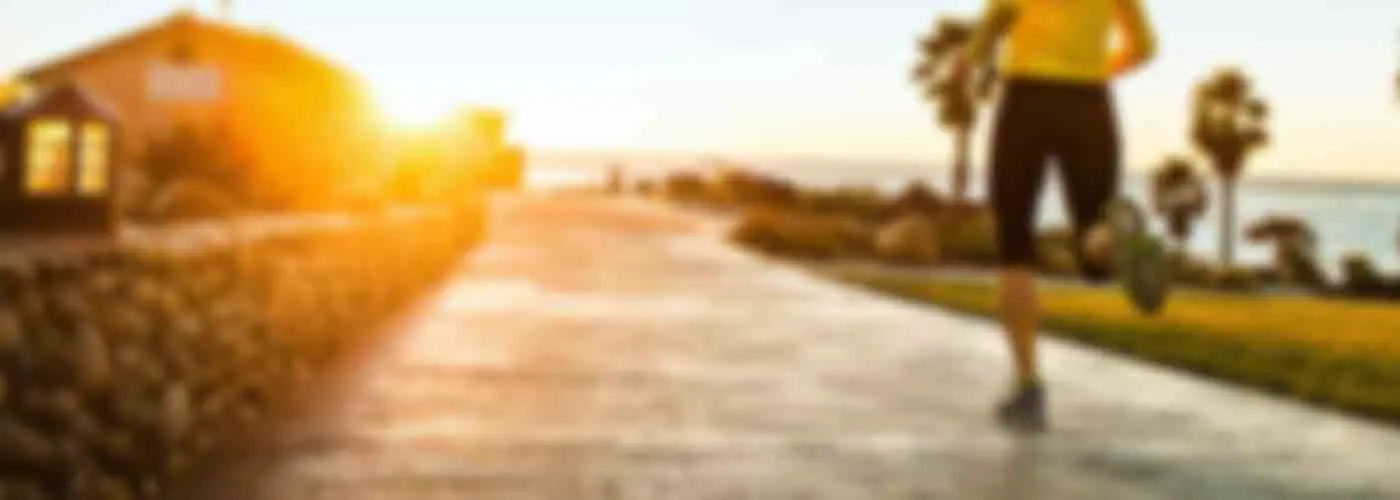

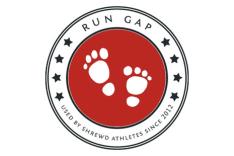



Discuss This Article